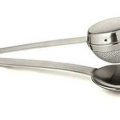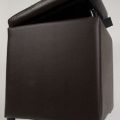1843
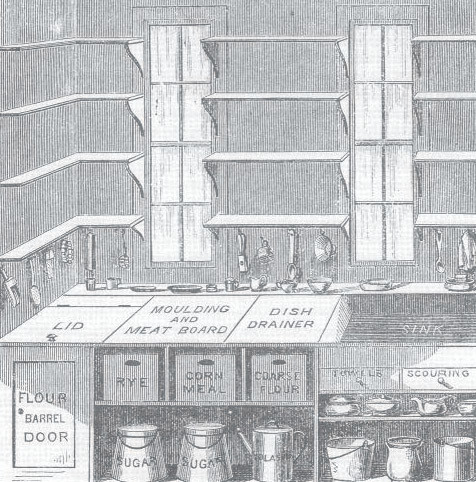 History of the kitchen Idea fundamentally newthe arrangement of the kitchen belongs to the determined American lady Katarina Beecher, who became famous for her self-instruction manuals on home economics. Believing that there will be times when there will be no cooks and maids at all, in 1843 she published the book "The House of the American Woman", in which she describes a small, compact, filled with cupboards and drawers.
History of the kitchen Idea fundamentally newthe arrangement of the kitchen belongs to the determined American lady Katarina Beecher, who became famous for her self-instruction manuals on home economics. Believing that there will be times when there will be no cooks and maids at all, in 1843 she published the book "The House of the American Woman", in which she describes a small, compact, filled with cupboards and drawers. This kitchen, "copied" from steamboat galley(Beecher often sailed on the Mississippi), and became the prototype of the "ideal" type kitchen, on which one person can easily manage. By the way, the co-author of the supplemented edition of 1869 was Katharina's sister, writer Harriet Beecher Stowe, author of the textbook "Uncle Tom's Cabin," known for its intransigence with regard to slavery. Cooking including.
This kitchen, "copied" from steamboat galley(Beecher often sailed on the Mississippi), and became the prototype of the "ideal" type kitchen, on which one person can easily manage. By the way, the co-author of the supplemented edition of 1869 was Katharina's sister, writer Harriet Beecher Stowe, author of the textbook "Uncle Tom's Cabin," known for its intransigence with regard to slavery. Cooking including.
1913
In the Ladies' Home Journal appears column ChristineFrederic, devoted to the rationalization of the household. In addition to recommendations for fast and high-quality washing of dishes and cleaning beans, she writes a lot about the layout of the kitchen. And this is not just theory: Mrs. Frederick (she asks for it only this way) organizes a whole laboratory on Long Island, where she learns the movements of the housewives in the kitchen with the help of a long thread (a thread whose length is measured at the end of the day or one worker is attached to the foot of the subjects process). As a result, Mrs. Frederic argues that with a more thoughtful planning of the kitchen and dividing it into zones: cooking, washing, storage, - the landlady can save almost half a kilometer of steps a day. In 1920, Frederic wrote the book "Housekeeping Engineering", which quickly turns into a bestseller.
1920s
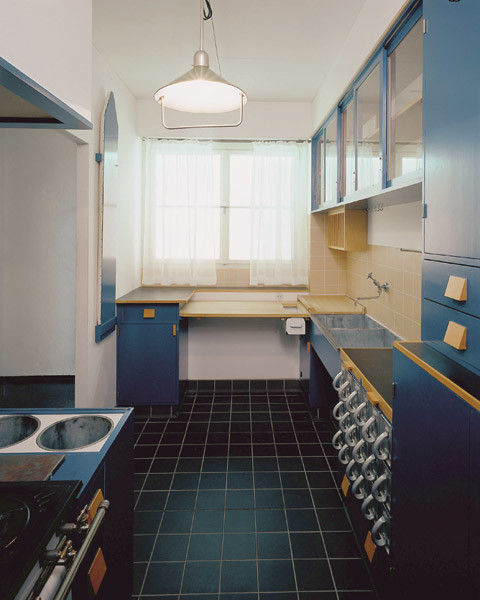 To improve the kitchen connects LillianGilbert - one of the most extraordinary women in the history of America. A mother of 12 (!) Children, she is also a talented engineer (the author of many patents), an industrial psychologist and one of the pioneers of scientific management and ergonomics. In order not to get bogged down in such routine work, Gilbert is seriously engaged in the kitchen ergonomics: he polls about 400 housewives and sketches the movements in the kitchen of his numerous family, so that with a stopwatch and a ruler in hand, calculate the optimal layout of kitchen furniture, its shape and dimensions. The result - the samples of "practical kitchen", created by Gilbert in accordance with its own developed laws of ergonomics. About the attention with which Lillian Gilbert refers to the economy of efforts in the kitchen, say her inventions: a trash can with a pedal, shelves on the refrigerator door, an electric mixer. Fewer movements, more achievements!
To improve the kitchen connects LillianGilbert - one of the most extraordinary women in the history of America. A mother of 12 (!) Children, she is also a talented engineer (the author of many patents), an industrial psychologist and one of the pioneers of scientific management and ergonomics. In order not to get bogged down in such routine work, Gilbert is seriously engaged in the kitchen ergonomics: he polls about 400 housewives and sketches the movements in the kitchen of his numerous family, so that with a stopwatch and a ruler in hand, calculate the optimal layout of kitchen furniture, its shape and dimensions. The result - the samples of "practical kitchen", created by Gilbert in accordance with its own developed laws of ergonomics. About the attention with which Lillian Gilbert refers to the economy of efforts in the kitchen, say her inventions: a trash can with a pedal, shelves on the refrigerator door, an electric mixer. Fewer movements, more achievements!
1926
 All the ideas and theories that have been developed finallyfirst standard project of a functional kitchen. This project of the architect Margaret Shute-Lihocki was called "Frankfurt cuisine", since it was mandatory to install ten thousand apartments in Frankfurt. Immediately a few of the floating in the air, but never realized ideas were embodied in this miniature (1,87 x 3,44 m) kitchen. All the necessary furniture and equipment (stove, sink, work desk, cabinets) are compact and have the same height, which makes it possible to organize the work more rationally. Instead of legs, furniture is placed on a special base - it is stable and hygienic. The usual buffet is divided in half: on the lower cabinet-table and the top cupboard. Even the color of the kitchen - beige-gray tiles and blue wooden modules - obeys the need. Margaret heard somewhere that these colors scare away flies. In general, in such a kitchen, a woman can finally feel like a "housekeeping engineer", and not just a cook.
All the ideas and theories that have been developed finallyfirst standard project of a functional kitchen. This project of the architect Margaret Shute-Lihocki was called "Frankfurt cuisine", since it was mandatory to install ten thousand apartments in Frankfurt. Immediately a few of the floating in the air, but never realized ideas were embodied in this miniature (1,87 x 3,44 m) kitchen. All the necessary furniture and equipment (stove, sink, work desk, cabinets) are compact and have the same height, which makes it possible to organize the work more rationally. Instead of legs, furniture is placed on a special base - it is stable and hygienic. The usual buffet is divided in half: on the lower cabinet-table and the top cupboard. Even the color of the kitchen - beige-gray tiles and blue wooden modules - obeys the need. Margaret heard somewhere that these colors scare away flies. In general, in such a kitchen, a woman can finally feel like a "housekeeping engineer", and not just a cook.
1930s
 To get used to something new, it always takes time. Only in the 1930s the kitchen modules finally replaced the free-standing cabinets and slides.
To get used to something new, it always takes time. Only in the 1930s the kitchen modules finally replaced the free-standing cabinets and slides.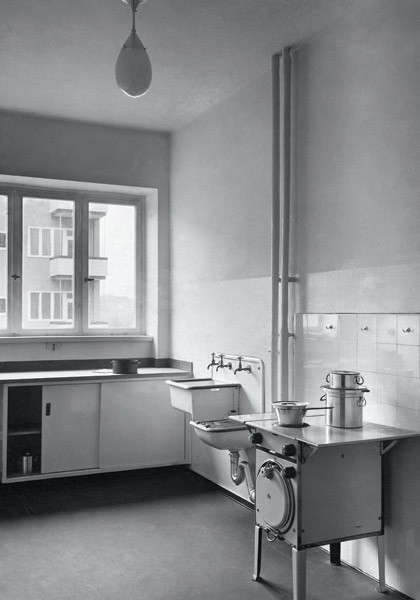 Catalogs are full of variety of variations -kitchens from floor to ceiling, kitchens arranged around the sink, kitchens with many drawers and doors, covered with a common wooden countertop, sometimes decorated with tiles. Such sets are called "Swedish cuisine", now only they are in fashion. Sideboards and slides go to the attic!
Catalogs are full of variety of variations -kitchens from floor to ceiling, kitchens arranged around the sink, kitchens with many drawers and doors, covered with a common wooden countertop, sometimes decorated with tiles. Such sets are called "Swedish cuisine", now only they are in fashion. Sideboards and slides go to the attic!
1950s
 In the kitchens again a revolution: new materials are emerging. First, in Italy, and then throughout Europe, the cuisine becomes more and more colorful.
In the kitchens again a revolution: new materials are emerging. First, in Italy, and then throughout Europe, the cuisine becomes more and more colorful. 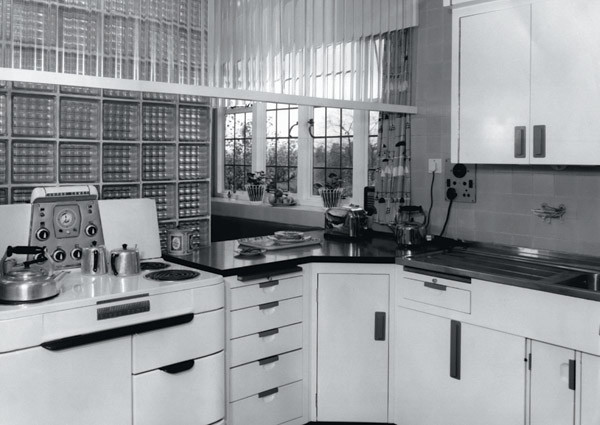 An old kind lacquered tree is considereda lot of conservatives, replaced by plastic, stainless steel, anodized aluminum, rubber. Wear-resistant, hygienic, bright and futuristic - these materials quickly fill the interiors. After successful tests in the kitchen, which in these years becomes a real design laboratory, they occupy a worthy place in the whole house. Do not lag behind them and household appliances: steel and multicolored, it turns into a kitchen decoration.
An old kind lacquered tree is considereda lot of conservatives, replaced by plastic, stainless steel, anodized aluminum, rubber. Wear-resistant, hygienic, bright and futuristic - these materials quickly fill the interiors. After successful tests in the kitchen, which in these years becomes a real design laboratory, they occupy a worthy place in the whole house. Do not lag behind them and household appliances: steel and multicolored, it turns into a kitchen decoration.
1960
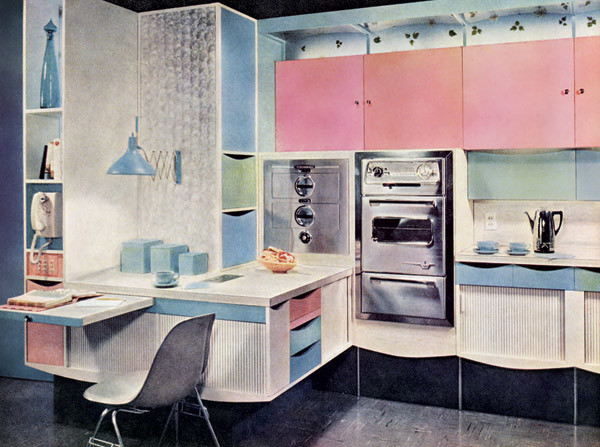 The era of space exploration in the 1960s leads tomass hobby for all disposable (disposable tableware is a special chic), and the emergence of powerful freezers - the distribution of semi-finished products. Cooking can now be much less likely, and cleaning after parties is much easier. The process of cooking from tedious duties is transformed into a pleasant hobby or creative activity. This is considered not only by women, but also by men, which can not but affect the status of the kitchen, which is growing rapidly, attracting more and more designers to work with kitchen furniture. Kitchen fill new household appliances - the more of them, the more prestigious.
The era of space exploration in the 1960s leads tomass hobby for all disposable (disposable tableware is a special chic), and the emergence of powerful freezers - the distribution of semi-finished products. Cooking can now be much less likely, and cleaning after parties is much easier. The process of cooking from tedious duties is transformed into a pleasant hobby or creative activity. This is considered not only by women, but also by men, which can not but affect the status of the kitchen, which is growing rapidly, attracting more and more designers to work with kitchen furniture. Kitchen fill new household appliances - the more of them, the more prestigious.
1969
 Two news at once. Traditionally, it's good first: DuPont patented artificial Sorian stone, from which you can make seamless surfaces of any size. Very soon, Corian becomes a favorite material for kitchen countertops, allowing you to create a variety of combinations that look like a single whole. The second news will seem to somebody an annoying restriction: the European Committee finally introduced the general standards for kitchen modules: the height of the lower cabinets is 85 cm, the depth is 60 cm, the depth of the cabinet is 35 cm, etc. Now designers are encouraged to experiment mainly with materials, color and shape, without changing the basic dimensions. But this does not stop everyone. For example, Luigi Collani is just at this time doing for the brand Poggenpohl conceptual kitchen-ball Experiment 70.
Two news at once. Traditionally, it's good first: DuPont patented artificial Sorian stone, from which you can make seamless surfaces of any size. Very soon, Corian becomes a favorite material for kitchen countertops, allowing you to create a variety of combinations that look like a single whole. The second news will seem to somebody an annoying restriction: the European Committee finally introduced the general standards for kitchen modules: the height of the lower cabinets is 85 cm, the depth is 60 cm, the depth of the cabinet is 35 cm, etc. Now designers are encouraged to experiment mainly with materials, color and shape, without changing the basic dimensions. But this does not stop everyone. For example, Luigi Collani is just at this time doing for the brand Poggenpohl conceptual kitchen-ball Experiment 70.
1980
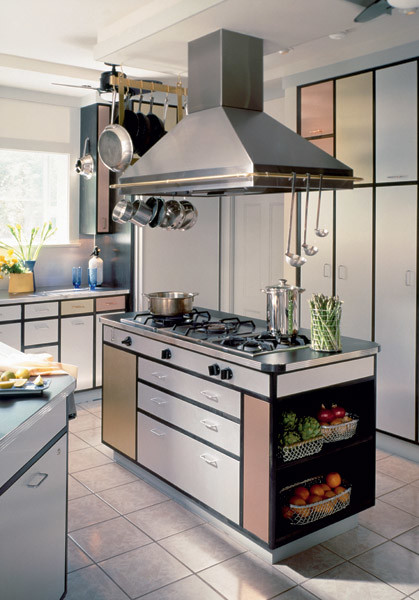 As it often happens, not too remarkablethe event entailed a lot of consequences. Improving the design of the hood in the 1980s leads to a complete rethinking of the place of the kitchen in the house. Now with a powerful hood can not isolate the kitchen from other premises. Very soon, the "studio" layout with an open space that unites the kitchen, living room and dining room becomes popular. The kitchen is now in sight. It immediately finds a response from the best architects and designers: furniture companies are starting to release one breakthrough model after another. Now the kitchen - not just a full house in the house, but also a real object of prestige.
As it often happens, not too remarkablethe event entailed a lot of consequences. Improving the design of the hood in the 1980s leads to a complete rethinking of the place of the kitchen in the house. Now with a powerful hood can not isolate the kitchen from other premises. Very soon, the "studio" layout with an open space that unites the kitchen, living room and dining room becomes popular. The kitchen is now in sight. It immediately finds a response from the best architects and designers: furniture companies are starting to release one breakthrough model after another. Now the kitchen - not just a full house in the house, but also a real object of prestige.
1990
The general interest in minimalism imposes its ownimprint and the appearance of kitchen furniture: all unnecessary (albeit necessary), but capable of breaking the harmony and purity of the overall appearance, carefully hides behind the doors and sliding panels. With hidden attributes (stove, appliances) the kitchen sometimes ceases to look like a kitchen and turns into an abstract art object.
2000+
Today, the kitchen is still the maina laboratory of design where new technologies and materials are tested. It is not yet clear whether it will remain built-in and subordinate to the standards or in the fashion will enter something streamlined and shapeless. The main thing is different. One and a half centuries of struggle were not wasted. We can say with confidence: there is no kitchen slavery anymore! And the design in this played an important role. Marina Grishina







